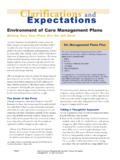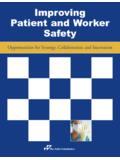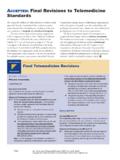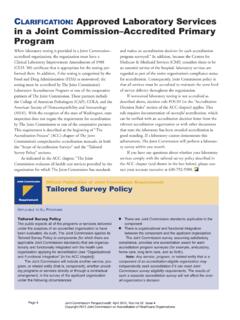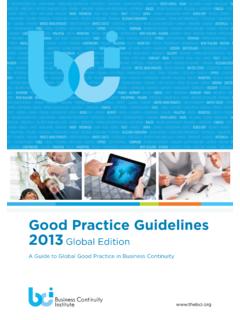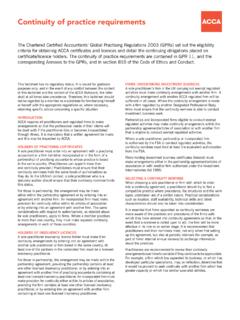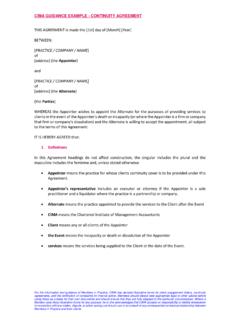Transcription of Emergency management: Need for continuity of operations ...
1 Legal disclaimer: This material is meant as an information piece only; it is not a standard or a Sentinel Event Alert. The intent of Quick Safety is to raise awareness and to be helpful to Joint Commission-accredited organizations. The information in this publication is derived from actual events that occur in health care. 2018 The Joint Commission, Division of Healthcare Improvement Issue 41 | May 2018 Emergency management: Need for continuity of operations planning Issue: Power failure, fire, flood, industrial accident, cyberattack disasters such as these can put both health care organizations and their patients at risk.
2 The critical need for continuity of operations planning (COOP) is most evident when an organization becomes the victim of an Emergency . This planning provides health care organizations with the resilience needed to protect, respond, recover and restore essential patient care services. Following a disaster, an organization s capability to provide care, treatment and services to patients can be disrupted for days, weeks, several months or longer. continuity of operations planning ensures the ability to continue essential business operations , patient care services, and ancillary support functions across a wide range of potential emergencies.
3 The health care organization s continuity of operations planning may be an annex to the organization s Emergency operations plan (EOP) and during a response should be addressed under the incident command system (ICS). 1 When the health care organization itself is compromised, so is patient safety. In the aftermath of emergencies, disruptions in health system capabilities can put patients at risk, especially vulnerable patients, such as the elderly; those with chronic conditions requiring oxygen, dialysis or other regular interventions; and those with mobility or communication impairments.
4 A continuity of operations strategy is an essential component of Emergency management planning; while the goal of Emergency management planning is to provide care to individuals who are incapacitated by emergencies, a continuity of operations strategy focuses on the organization. The goal is to protect the organization s physical plant, information technology systems, business and financial operations , and other infrastructure from direct disruption or damage so that it can continue to function throughout or shortly after an Emergency . Strong continuity of operations planning lays a foundation for leadership decision-making regarding sheltering in place, closing services, or evacuating the organization.
5 Even in situations where an organization leases or rents its space, the organization will need to coordinate with the owner(s) to determine the extent to which the organization s essential infrastructure, supplies and equipment can be protected. In light of disasters in recent months that have resulted in widespread disruption and extended periods of recovery, continuity of operations planning is essential for mitigating impacts to organization functions, staff and structures. The following recent events put health care organizations and patients at risk: Chemical contamination of a municipal water supply threatened care to hundreds of dialysis patients, requiring ambulatory and hospital-based providers to coordinate quickly on immediate needs, and then on longer infrastructure solutions.
6 In the aftermath of wildfires, floods and other natural disasters, on-going roadblocks and damaged communication systems complicated home care agencies ability to deploy staff safely for essential home visits. A ransomware attack at a large medical center compromised IT systems for two weeks. Laboratory and radiology had to manually write results and use runners between sending and receiving units, and pharmacy had to unlock automated medication dispensing machines and increase rounding. Following a hurricane, an 11-story hospital in a remote community lost service to all elevators for over 24 hours.
7 Staff and family members formed a human chain to move supplies, meals, and some patients up and down stairs until some elevator service was restored. In the northern California wildfires, the largest health center in the community had a roof fire and sprinklers running for seven hours. Equipment, supplies and facilities were severely damaged by fire, water, smoke, and were vulnerable to looting due to the narcotics and pharmaceutical supplies that remained. Restoration of the facility is underway and is expected to take 12 months, impacting over 20,000 patients.
8 In communities that experienced repeated floods or fires in recent years, many health care workers left the area due to lack of available housing. Quick Safety Issue 41, May 2018 Page | 2 Legal disclaimer: This material is meant as an information piece only; it is not a standard or a Sentinel Event Alert. The intent of Quick Safety is to raise awareness and to be helpful to Joint Commission-accredited organizations. The information in this publication is derived from actual events that occur in health care. 2018 The Joint Commission, Division of Healthcare Improvement Best practice in continuity of operations planning includes, at a minimum, the following: continuity of facilities and communications to support organizational functions.
9 A succession plan that lists who replaces the key leader(s) during an Emergency if the leader is not available to carry out his or her duties. A delegation of authority plan that describes the decisions and policies that can be implemented by authorized successors. Safety actions to consider: After reviewing the initial survey results of The Joint Commission s new Emergency Management requirements under the Centers for Medicare & Medicaid Services (CMS) Emergency Management Final Rule, continuity of operations planning has emerged as one of the issues that Joint Commission-accredited organizations need to address better in order to be more resilient during and after the occurrence of disasters and emergencies.
10 continuity of operations planning is a significant concern in community-based settings as well as inpatient settings, and the following actions can be applied to and utilized by any health care organization. 1. Succession and delegations: The organization s documented leadership succession and delegations of authority should clearly indicate that successor individuals have been designated, and that the actions these individuals are authorized to implement are defined. These delegations will encompass internal decisions of the organization, and depending on the defined response activities, coordination of operations with the community s incident command.


